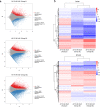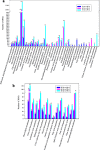Identification of genes associated with the biosynthesis of unsaturated fatty acid and oil accumulation in herbaceous peony 'Hangshao' (Paeonia lactiflora 'Hangshao') seeds based on transcriptome analysis
- PMID: 33522906
- PMCID: PMC7849092
- DOI: 10.1186/s12864-020-07339-7
Identification of genes associated with the biosynthesis of unsaturated fatty acid and oil accumulation in herbaceous peony 'Hangshao' (Paeonia lactiflora 'Hangshao') seeds based on transcriptome analysis
Abstract
Background: Paeonia lactiflora 'Hangshao' is widely cultivated in China as a traditional Chinese medicine 'Radix Paeoniae Alba'. Due to the abundant unsaturated fatty acids in its seed, it can also be regarded as a new oilseed plant. However, the process of the biosynthesis of unsaturated fatty acids in it has remained unknown. Therefore, transcriptome analysis is helpful to better understand the underlying molecular mechanisms.
Results: Five main fatty acids were detected, including stearic acid, palmitic acid, oleic acid, linoleic acid and α-linolenic acid, and their absolute contents first increased and then decreased during seed development. A total of 150,156 unigenes were obtained by transcriptome sequencing. There were 15,005 unigenes annotated in the seven functional databases, including NR, NT, GO, KOG, KEGG, Swiss-Prot and InterPro. Based on the KEGG database, 1766 unigenes were annotated in the lipid metabolism. There were 4635, 12,304, and 18,291 DEGs in Group I (60 vs 30 DAF), Group II (90 vs 60 DAF) and Group III (90 vs 30 DAF), respectively. A total of 1480 DEGs were detected in the intersection of the three groups. In 14 KEGG pathways of lipid metabolism, 503 DEGs were found, belonging to 111 enzymes. We screened out 123 DEGs involved in fatty acid biosynthesis (39 DEGs), fatty acid elongation (33 DEGs), biosynthesis of unsaturated fatty acid (24 DEGs), TAG assembly (17 DEGs) and lipid storage (10 DEGs). Furthermore, qRT-PCR was used to analyze the expression patterns of 16 genes, including BBCP, BC, MCAT, KASIII, KASII, FATA, FATB, KCR, SAD, FAD2, FAD3, FAD7, GPAT, DGAT, OLE and CLO, most of which showed the highest expression at 45 DAF, except for DGAT, OLE and CLO, which showed the highest expression at 75 DAF.
Conclusions: We predicted that MCAT, KASIII, FATA, SAD, FAD2, FAD3, DGAT and OLE were the key genes in the unsaturated fatty acid biosynthesis and oil accumulation in herbaceous peony seed. This study provides the first comprehensive genomic resources characterizing herbaceous peony seed gene expression at the transcriptional level. These data lay the foundation for elucidating the molecular mechanisms of fatty acid biosynthesis and oil accumulation for herbaceous peony.
Keywords: Differentially expressed gene; Fatty acid biosynthesis; Paeonia lactiflora ‘Hangshao’; Transcriptome; qRT-PCR.
Conflict of interest statement
The authors declare that they have no competing interests.
Figures








Similar articles
-
Identification of key genes for triacylglycerol biosynthesis and storage in herbaceous peony (Paeonia lactifolra Pall.) seeds based on full-length transcriptome.BMC Genomics. 2024 Jun 15;25(1):601. doi: 10.1186/s12864-024-10513-w. BMC Genomics. 2024. PMID: 38877407 Free PMC article.
-
Fatty acid composition of developing tree peony (Paeonia section Moutan DC.) seeds and transcriptome analysis during seed development.BMC Genomics. 2015 Mar 18;16(1):208. doi: 10.1186/s12864-015-1429-0. BMC Genomics. 2015. PMID: 25887415 Free PMC article.
-
Transcriptomic analysis of Perilla frutescens seed to insight into the biosynthesis and metabolic of unsaturated fatty acids.BMC Genomics. 2018 Mar 21;19(1):213. doi: 10.1186/s12864-018-4595-z. BMC Genomics. 2018. PMID: 29562889 Free PMC article.
-
Oil-use Feature of Tree Peony Seed Oil and Its Application in Functional Food Field.Chem Biodivers. 2025 Apr 17:e202500431. doi: 10.1002/cbdv.202500431. Online ahead of print. Chem Biodivers. 2025. PMID: 40247429 Review.
-
Could peony seeds oil become a high-quality edible vegetable oil? The nutritional and phytochemistry profiles, extraction, health benefits, safety and value-added-products.Food Res Int. 2022 Jun;156:111200. doi: 10.1016/j.foodres.2022.111200. Epub 2022 Mar 30. Food Res Int. 2022. PMID: 35651052 Review.
Cited by
-
Integrative Analysis of Iso-Seq and RNA-Seq Identifies Key Genes Related to Fatty Acid Biosynthesis and High-Altitude Stress Adaptation in Paeonia delavayi.Genes (Basel). 2025 Jul 30;16(8):919. doi: 10.3390/genes16080919. Genes (Basel). 2025. PMID: 40869970 Free PMC article.
-
Cut peony industry: the first 30 years of research and new horizons.Hortic Res. 2022 Apr 11;9:uhac079. doi: 10.1093/hr/uhac079. eCollection 2022. Hortic Res. 2022. PMID: 35669702 Free PMC article.
-
Identification of genes associated with fatty acid biosynthesis based on 214 safflower core germplasm.BMC Genomics. 2023 Dec 11;24(1):763. doi: 10.1186/s12864-023-09874-5. BMC Genomics. 2023. PMID: 38082219 Free PMC article.
-
Integrated Lipidomic and Transcriptomic Analysis Reveals Lipid Metabolism in Foxtail Millet (Setaria italica).Front Genet. 2021 Nov 16;12:758003. doi: 10.3389/fgene.2021.758003. eCollection 2021. Front Genet. 2021. PMID: 34868233 Free PMC article.
-
Identification of key genes for triacylglycerol biosynthesis and storage in herbaceous peony (Paeonia lactifolra Pall.) seeds based on full-length transcriptome.BMC Genomics. 2024 Jun 15;25(1):601. doi: 10.1186/s12864-024-10513-w. BMC Genomics. 2024. PMID: 38877407 Free PMC article.
References
-
- Qing KJ. Illustrtion of one hundred ornamental flowers bonsai-the herbaceous peony. Beijing: China Forestry Press; 2004.
-
- Zhu MX, Li SN, You HD, Han B, Wang ZP, Hu YX, et al. Simultaneous determination of paeoniflorin and albiflorin in radix paeoniae Rubra by HPLC–DAD–ELSD. Acta Chromatogr. 2017;29(2):279–289. doi: 10.1556/1326.2017.29.2.12. - DOI
MeSH terms
Substances
Grants and funding
LinkOut - more resources
Full Text Sources
Other Literature Sources
Molecular Biology Databases
Research Materials
Miscellaneous

